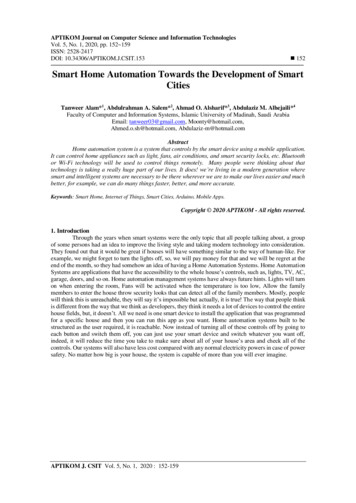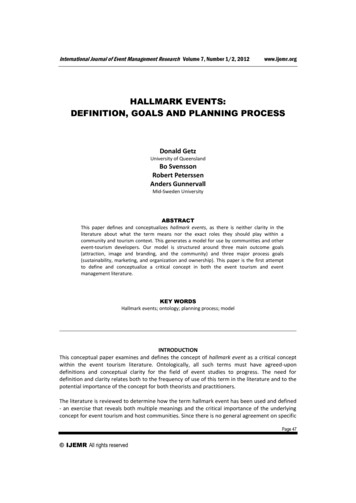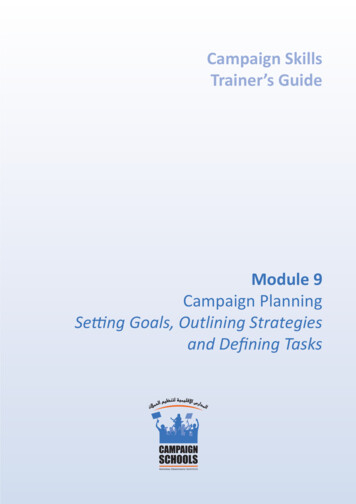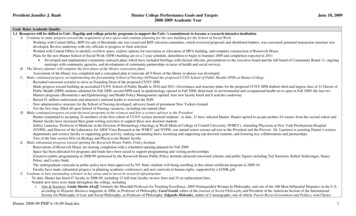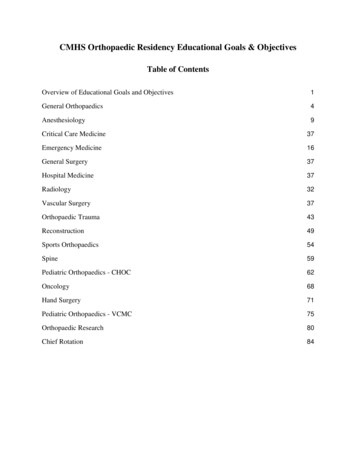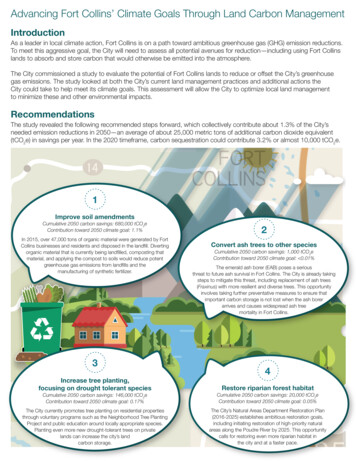
Transcription
Performance Appraisal Planning 2016-2017SMART Goals: A How to GuideSMART Goals:A How to Guide1
Performance Appraisal Planning 2016-2017SMART Goals: A How to GuideTable of ContentsWhat are SMART Goals? .3What is the SMART criteria? .3How do I decide the right scope for my SMART Goals? (How big? How many?) .3Where to start? . 3How to write your S-M-A-R-T goal .4Examples of Creating a SMART Goal .7Goal: I want to complete a project . 7Goal: I want to improve my performance . 8Appendix . 10Template for writing a S.M.A.R.T. Goal . 11More SMART Goal Examples . 12Ongoing . 12New Project/Performance Cycle-Specific . 12Development Goals. 132
Performance Appraisal Planning 2016-2017SMART Goals: A How to GuideHow to Write SMART Goals:A Guide for Managers and EmployeesWhat are SMART Goals? Statements of the important results you are working to accomplish Designed in a way to foster clear and mutual understanding of what constitutesexpected levels of performance and successful professional developmentWhat is the SMART Time-BoundWhat will be accomplished? What actions will youtake?What data will measure the goal? (How much? Howwell?Is the goal doable? Do you have the necessary skillsand resources?How does the goal align with broader goals? Why isthe result important?What is the time frame for accomplishing the goal?How do I decide the right scope for my SMART Goals? (How big? How many?)SMART goals are meant to address all of your major job responsibilities.Remember, goals are intended to focus attention and resources on what is most importantso that you can be successful in achieving your priorities. SMART Goals are goals for yourday-to-day job. Common types of goals are to:o Increase somethingo Make somethingo Improve somethingo Reduce somethingo Save somethingo Develop someone (yourself!)Where to start?1. Start by thinking about your whole job and the broad areas (or “buckets”) ofresponsibility and results for which you are accountable.2. Develop a goal statement for each bucket. To get the scope right, remember tofocus on end results not tasks.3
Performance Appraisal Planning 2016-2017SMART Goals: A How to GuideGoals should be high level enough to encompass the core outcomes for which youare responsible, but specific and clear enough so you will be able to measuresuccess.4. Goals should be on-going job responsibilities and any new projects, assignments,priorities, or initiatives that are specific to this performance cycle.5. Having too many goals can be an indicator that your goals are scoped at too low alevel and are focused more on tasks than on end results.6. If it seems that your goals are becoming too numerous and task-oriented, it may behelpful to consider combining several goal statements into a broader outcome area.3.How to write your S-M-A-R-T goalS – SpecificWhen setting a goal, be specific about what you want to accomplish. Think about this as themission statement for your goal. This isn’t a detailed list of how you’re going to meet a goal, butit should include an answer to the popular ‘w’ questions: Who – Consider who needs to be involved to achieve the goal (this is especiallyimportant when you’re working on a group project). What – Think about exactly what you are trying to accomplish and don’t be afraid to getvery detailed. When – You’ll get more specific about this question under the “time-bound” section ofdefining S.M.A.R.T. goals, but you should at least set a time frame. Where – This question may not always apply, especially if you’re setting personal goals,but if there’s a location or relevant event, identify it here. Which – Determine any related obstacles or requirements. This question can bebeneficial in deciding if your goal is realistic. For example, if the goal is to open a bakingbusiness, but you’ve never baked anything before, that might be an issue. As a result,you may refine the specifics of the goal to be “Learn how to bake in order to open abaking business." Why – What is the reason for the goal? When it comes to using this method foremployees, the answer will likely be along the lines of company advancement or careerdevelopment.4
Performance Appraisal Planning 2016-2017 “S” actions may tTransition SMART Goals: A How to inisterNote that this list does not include verbs like “improve,” “reduce,” or “increase” (e.g.“Improve customer service” or “reduce cost.” These imply the direction that you want aresult to move in, but don’t do much to explain the role or specific action that you willtake to accomplish this change.M – MeasurableWhat metrics are you going to use to determine if you meet the goal? This makes a goal moretangible because it provides a way to measure progress. If it’s a project that’s going to take afew months to complete, then set some milestones by considering specific tasks to accomplish.Milestones are a series of steps along the way that when added up will result in the completionof your main goal. As the “M” in SMART states, there should be a source of information to measure ordetermine whether a goal has been achieved.The M is a direct (or possibly indirect) indicator of what success for a particular goal willlook like.Sometimes measurement is difficult and managers and employees will need to worktogether to identify the most relevant and feasible data sources and collection methods.Data collection efforts needed to measure a goal can be included in that goal’s actionplan.Even if a perfect, direct measurement source is not immediately feasible for a givengoal, the discussion about the desired end result (why this goal is important) and whatthe measurement options are (what success might look like) is an important andvaluable part of performance planning.Measurement methods can be both quantitative (productivity results, money saved orearned, etc.) and qualitative (client testimonials, surveys, etc.).5
Performance Appraisal Planning 2016-2017 SMART Goals: A How to GuideSome typical data types and data collection methods may include:DATA TYPESQuality/accuracy ratesAmounts producedRevenue generatedProductivity ratesCustomer SatisfactionDATA COLLECTION METHODSAutomated reportsAudits, testsSurveysWork products, samplesOther documentsA – AchievableThis focuses on how important a goal is to you and what you can do to make it attainable andmay require developing new skills and changing attitudes. The goal is meant to inspiremotivation, not discouragement. Think about: how to accomplish the goal,if you have the tools/skills needed,if not, consider what it would take to attain them.R – RelevantRelevance refers focusing on something that makes sense with the broader business goals. Forexample, if the goal is to launch a new program or service, it should be something that’s inalignment with the overall business/department objectives. Your team may be able to launch anew program, but if your division is not prioritizing launching that type of new programs, thenthe goal wouldn’t be relevant.T – Time-BoundAnyone can set goals, but if it lacks realistic timing, chances are you’re not going to succeed.Providing a target date for deliverables is imperative. Ask specific questions about the goaldeadline and what can be accomplished within that time period. If the goal will take threemonths to complete, it’s useful to define what should be achieved half-way through theprocess. Providing time constraints also creates a sense of urgency.The Easiest Way to Write S.M.A.R.T. GoalsWhen it comes to writing S.M.A.R.T. goals, ask yourself and other team members a lot ofquestions. The answers will help fine-tune your strategy, ensuring the goals are somethingthat’s actually attainable. Utilize the template provided in the appendix as a guide.6
Performance Appraisal Planning 2016-2017SMART Goals: A How to GuideThis doesn’t have to be a daunting experience; in fact, it should be quite illuminating. Below wedemonstrate how to write S.M.A.R.T. goals for two typical business scenarios: completing aproject and improving personal performance. We’ve also created an easy-to-use S.M.A.R.T.goals template and worksheet to help you get started.Examples of Creating a SMART GoalHere are two examples of initial goals we'll use to walk through this process:1. I want to complete a project2. I want to improve my performanceThis is a typical approach to creating goals, but both of these are very vague. With the currentwording, the goals probably aren’t going to be attainable. The statements lack specifics,timelines, motivation, and a reality check.Now, let’s use the S.M.A.R.T. goals formula to clarify both and create new and improved goals.Goal: I want to complete a project Specific: Many people are accessing our current site from their mobile devices. Since it’snot a responsive site, it provides a poor experience for customers. I want to launch amobile app for my company website by the end of June, which requires involvementfrom software development, design, and marketing. Measurable: Creating a mobile app for our company site will require a lot of resources.To make it worthwhile, I’d like to have 50,000 installs of the site within six months oflaunch. I’d also like to show a 5% conversion rate from customers using the mobile site. Achievable: The departments that will be involved have signed-off on creating a mobileapp. I’ll need to manage the project and set milestones to keep everyone motivated andon target. Relevant: Improving the customer experience on mobile devices is a core initiative formy company this year. Time-Bound: In order to achieve 50,000 mobile app installs and a 5% conversion rate bythe end of the fiscal year, the app will need to be launched by Q2 with a robustmarketing campaign that should continue through the end of the year.7
Performance Appraisal Planning 2016-2017SMART Goals: A How to GuideGoal: I want to improve my performance Specific: I received low marks on my ability to use PowerPoint at my last performancereview. Improving my skills requires that I learn how to use PowerPoint efficiently andpractice using it by creating various presentations. I’d like to be more proficient usingPowerPoint in time for my next review in six months. Measurable: By the time of my next review, I should be able to create presentationsthat incorporate graphs, images, and other media in a couple of hours. I should also beable to efficiently use and create templates in PowerPoint that my coworkers can alsouse. Achievable: Improving my PowerPoint skills is instrumental in moving forward in mycareer and receiving a better performance review. I can set time aside every week towatch PowerPoint tutorials and even enroll in an online class that can teach me newskills. I can also ask coworkers and my manager for PowerPoint tips. Relevant: Working with PowerPoint is currently 25% of my job. As I move up in thecompany, I’ll need to spend 50% of my time creating PowerPoint presentations. I enjoymy career and want to continue to grow within this company. Time-Bound: In six months, I should be proficient in PowerPoint ensuring it onlyoccupies 25% of my workload instead of the nearly 40% of the time it occupies now.Once you go through and write your goals according to each S.M.A.R.T. characteristic, you canthen combine and consolidate all the work you’ve done into one S.M.A.R.T. goal.S.M.A.R.T. goal: I want to complete a project Description: Improving the customer experience on mobile devices is a core initiativefor my company this year, so we are going to create a mobile app. By the end of thefiscal year, there should be 50,000 installs of the mobile app we develop, and it shouldproduce a 5% conversion rate. We’ll build the mobile app in-house and launch it by theend of June with an app-related marketing campaign that will continue to the end of theyear. Milestone: Mobile app launches end of June.8
Performance Appraisal Planning 2016-2017 SMART Goals: A How to GuideDeadline: End of the fiscal year.S.M.A.R.T. goal: I want to improve my performance Description: To grow in my career, I need to improve my PowerPoint skills. By takingonline classes and reviewing tutorials, I’ll improve my PowerPoint skills so that it onlyrequires 25% of my work time. Milestone: Complete an online PowerPoint course in three months. Deadline: Next employee review in six months.9
Performance Appraisal Planning 2016-2017SMART Goals: A How to GuideAppendix10
Performance Appraisal Planning 2016-2017SMART Goals: A How to GuideTemplate for writing a S.M.A.R.T. GoalCrafting S.M.A.R.T. Goals are designed to help you identify if what you want to achieve isrealistic and determine a deadline. When writing S.M.A.R.T. Goals use concise language, butinclude relevant information. These are designed to help you succeed, so be positive whenanswering the questions.Initial Goal (Write the goal you have in mind):1. Specific (What do you want to accomplish? Who needs to be included? When do you want todo this? Why is this a goal?)2. Measurable (How can you measure progress and know if you’ve successfully met your goal?):3. Achievable (Do you have the skills required to achieve the goal? If not, can you obtain them?What is the motivation for this goal? Is the amount of effort required on par with what the goalwill achieve?):4. Relevant (Why am I setting this goal now? Is it aligned with overall objectives?):5. Time-bound (What’s the deadline and is it realistic?):S.M.A.R.T. Goal (Review what you have written, and craft a new goal statement based on whatthe answers to the questions above have revealed):11
Performance Appraisal Planning 2016-2017SMART Goals: A How to GuideMore SMART Goal ExamplesOngoing Provide high quality customer service resulting in a 90% customer satisfaction rating fromexternal customers on accuracy, timeliness and courtesy measures on an ongoing basis.On an ongoing basis, reconcile the department financial reports by the 15th of every month withno increase in reconciliation errors.On an ongoing basis, accurately process and dispatch 95% of high priority calls for police, fireand medical services.On an ongoing basis, dispatch 82% of high priority calls for police, fire and medical serviceswithin established timeframes.Resolve 90% of complaints through a collaborative process without need for formal mediationon an ongoing basis.Conduct education, monitoring and enforcement to ensure that 98% of agricultural and pestcontrol businesses are in compliance with all pesticide regulatory requirements on an ongoingbasis.Manage and support effective performance resulting in achievement of 75% of program andindividual performance targets by the end of the fiscal year.Manage the department budget to stay within appropriations and accomplish 85% of serviceresults by the end of the fiscal year.Coach and support my direct reports resulting in attainment of 85% of all performance plangoals and feedback from direct reports that I provided them with clear expectations, meaningfulfeedback and fair performance evaluations by the end of the fiscal year.New Project/Performance Cycle-Specific By March 2011, develop and implement a customer service plan that results in department staffreporting that they are clear about expectations for excellent customer service and have theskills and support to perform at that level and that results in customers reporting that theyreceive excellent customer service.Transition to a new automated case management system with minimal affects on customerservice by developing a training program that ensures all staff can process 30 cases per day nolater than three months after the end of the training classes.Reduce overtime in the department from 150 hours per month to 50 hours per month by theend of the fiscal year with no increase in incident reports.Develop a quality improvement process for the sanitary sewer system that reduces the failurerate to 1% by 12/31/11.Create a partnership with at least 5 local cities to deliver two compliance-related trainingworkshops resulting in improvement in Net County Cost by 6/30/11.By 11/30/11, update the employee handbook to include a searchable intranet version thatemployees find easy to use and informative.Complete the Energy Watch Program to reduce countywide carbon emissions by 605 tons by theend of the fiscal year.12
Performance Appraisal Planning 2016-2017 SMART Goals: A How to GuideConduct outreach and education that reduces the amount of illegal dumping into the streetsand drainage channels by % by June 30, 2011.Develop and implement vehicle replacement plan to increase the Average Fuel Economy to 30Miles per Gallon by 2012 for Midsize and Compact Vehicles and to increase the average Milesper Gallon on the total fleet to 25 MPG by 2016.Implement Evidence Based Probation Service (EPBS) practices in order to reduce recidivismamong participants by % by June 30, 2011.Development Goals By June 30, 2011, develop and apply upgraded computer skills that enable me to producebudget reconciliation reports each month in a timely and accurate fashion.Develop and practice my coaching skills so that my direct reports report that they feel moresatisfied with their work and able to perform at a higher level and such that I achieve a 30/70split between coaching and doing by June 30, 2011.By June 30, 2011, complete course work and attain a CSAC credential to enhance my skills as aneffective leader as measured by feedback from my supervisor and the accomplishment of myperformance plan goals.13
SMART goals are meant to address all of your major job responsibilities. Remember, goals are intended to focus attention and resources on what is most important so that you can be successful in achieving your priorities.
